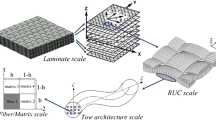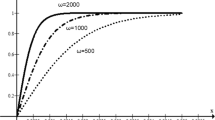Summary
The tensor polynomial strength theory for anisotropic materials was coupled with finite-element analyses to predict the ultimate load capacity of several wood-composite I-beams. Small-specimen tests with the constituent materials provided elastic constants for the finite-element computations and ultimate strengths for development of strength tensors.
Ultimate load capacity, failure modes, and sites of failures in wood composite I-beams were predicted. Analytical results were in excellent agreement with data from full-scale I-beam tests and demonstrated the influence of web joints and material strengths on failure characteristics.
Similar content being viewed by others
References
ADINA Engineering 1983: System theory and modeling guide. Rep. AE83-4. Watertown, MA: ADINA Engineering, Inc.
American Society for Testing and Materials 1974: Standard methods of static tests in structural sizes. ASTM D 198. Philadelphia, PA: ASTM
Bathe, K.-J. 1982: Finite element procedures in engineering analysis. Englewood Cliffs, NJ: Prentice-Hall, Inc.
Bender, D. A.; Woeste, F. E.; Schaffer, E. L.; Marx, C. M. 1985: Reliability formulation for the strength and fire endurance of glued-laminated beams. Res. Pap. FPL 460. Madison, WI: USDA For. Serv., For. Prod. Lab.
Collins, B. R.; Crane, R. L. 1971: A graphical representation of the failure surface of a composite. J. Compos. Mater. 5 (July): 408–413
Cowin, S. C. 1979: On the strength anisotropy of bone and wood. Trans. ASME 46(4): 832–838
Cramer, S. M.; Goodman, J. 1985: Failure modeling: basis of strength prediction in lumber. For. Prod. Res. Soc., Session 7 — Wood Engineering and Mechanical Properties, International meeting abstracts. Madison, WI
Fawcett, R.; Sack, R. L. 1977: Evaluation of shear web ply orientation for wood I-beams. ASCE J. Struct. Div. Proc. 103(ST3): 635–647
Fernandez, V. A.; Polensek, A. 1979: Model for predicting strength and stiffness of wood studs. Wood Sci. 12(2): 65–72
Foschi, R. O.; Barrett, J. D. 1980: Glue-laminated beam strength: a model. ASCE J. Struct. Div. 106(ST8): 1735–1754
Herakovich, C. T.; Nagarkar, A.; O'Brian, D. A. 1979: Failure analysis of composite laminates with free edges. In: Modern developments in composite materials and structures, pp. 53–66. New York: ASME-Aerospace Division
Johnson, J. A.; Ifju, G.; Roger, H. 1976: The performance of composite wood/particleboard beams under two-point loading. Wood Fiber 8(2): 85–97
Jones, R. M. 1975: Mechanics of composite materials. New York: McGraw-Hill Book Co.
Leichti, R. J. 1975: Assessing the reliability of wood composite I-beams. Ph.D. dissertation. Alabama Agricultural Experiment Station, Auburn University, AL
Leichti, R. J.; Tang, R. C. 1983: Analysis of wood composite I-beams with glued flange-webjoints. In: Spring Converence Proceedings. Society for Experimental Stress Analysis, pp. 45–50. Brookfield Center, MA
Liu, J. Y. 1984: Evaluation of the tensor polynomial strength theory for wood. J. Compos. Mater. 18(5): 216–226
Narayanaswami, R.; Adelman, H. M. 1977: Evaluation of the tensor polynomial and Hoffman theories for composite materials. J. Compos. Mater. 11 (October): 366–377
Norris, C. B. 1939: The elastic theory of wood failure. Trans. ASME 16(3): 259–261
Patton-Mallory, M.; Cramer, S. M. 1987: Fracture mechanics: a tool for predicting wood component strength. For. Prod. J. 37(7/8): 39–47
Ramaker, T. J.; Davister, M. D. 1972: Predicting performance of hardboard in I-beams. Res. Pap. FPL 185. Madison, WI: USDA For. Serv., For. Prod. Lab.
Suhling, J. C. 1986: Personal communication
Suhling, J. C.; Rowlands, R. E.; Johnson, M. W.; Gunderson, D. E. 1985: Tensorial strength analysis of paperboard. Exp. Mech. 25(1): 75–84
Superfesky, M. J.; Ramaker, T. J. 1976: Hardboard-webbed I-beams subject to short-term loading. Res. Pap. FPL 264. Madison, WI: USDA For. Serv., For. Prod. Lab.
Tennyson, R. C.; McDonald, D.; Nanyaro, A. P. 1978: Evaluation of the tensor polynomial failure criterion for composite materials. J. Compos. Mater. 12(1): 63–74
Tennyson, R. C.; Nanyaro, A. R.; Wharram, G. E. 1980: Application of the cubic polynomial strength criterion to the failure analysis of composite materials. J. Compos. Mater. Suppl. 14: 28–41
Tsai, S. W.; Hahn, H. T. 1980: Introduction to composite materials. Westport, CT: Technometric Publishing Co., Inc.
Tsai, S. W.; Wu, E. M. 1971: A general theory for strength of anisotropic materials. J. Compos. Mater. 5(1): 58–80
Wetherhold, R. C. 1985: Effect of stress concentration on the reliability of composite materials. J. Compos. Mater. 19(1): 19–28
Wetherhold, R. C.; Pipes, R. B. 1985: Statistics of fracture of composite materials under multiaxial loading. Mater. Sci. Eng. 68(1): 113–118
Wu, E. M. 1972: Optimal experimental measurements of anisotropic failure tensors. J. Compos. Mater. 6(10): 472–489
Wu, R.-Y.; Stachurski, Z. 1984: Evaluation of the normal stress interaction parameter in the polynomial strength theory for anisotropic materials. J. Compos. Mater. 18(9): 456–463
Author information
Authors and Affiliations
Additional information
The generous assistance of the Trus Joist Corporation, the Blandin Forest Products Company, and the Potlatch Corporation, and the financial support of the Cooperative State Research Service, USDA Forest Service, and the Alabama Agricultural Experiment Station at Auburn University are gratefully acknowledged. This is Paper 2316, Forest Research Laboratory, Oregon State University, Corvallis, Oregon
Rights and permissions
About this article
Cite this article
Leichti, R.J., Tang, R.C. Predicting the load capacity of wood composite I-beams using the tensor polynomial strenght theory. Wood Sci. Technol. 23, 109–121 (1989). https://doi.org/10.1007/BF00350933
Received:
Issue Date:
DOI: https://doi.org/10.1007/BF00350933




